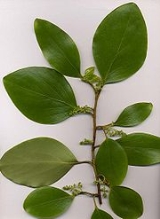
Griselinia
Overview
Shrub
A shrub or bush is distinguished from a tree by its multiple stems and shorter height, usually under 5–6 m tall. A large number of plants may become either shrubs or trees, depending on the growing conditions they experience...
s and tree
Tree
A tree is a perennial woody plant. It is most often defined as a woody plant that has many secondary branches supported clear of the ground on a single main stem or trunk with clear apical dominance. A minimum height specification at maturity is cited by some authors, varying from 3 m to...
s, with a highly disjunct distribution native to New Zealand
New Zealand
New Zealand is an island country in the south-western Pacific Ocean comprising two main landmasses and numerous smaller islands. The country is situated some east of Australia across the Tasman Sea, and roughly south of the Pacific island nations of New Caledonia, Fiji, and Tonga...
and South America
South America
South America is a continent situated in the Western Hemisphere, mostly in the Southern Hemisphere, with a relatively small portion in the Northern Hemisphere. The continent is also considered a subcontinent of the Americas. It is bordered on the west by the Pacific Ocean and on the north and east...
. It is a classic example of the Antarctic flora
Antarctic flora
The Antarctic flora is a distinct community of vascular plants which evolved millions of years ago on the supercontinent of Gondwana, and is now found on several separate areas of the Southern Hemisphere, including southern South America, southernmost Africa, New Zealand, Australia and New Caledonia...
.
It is the sole genus in the family Griseliniaceae; in the past it was often placed in the Cornaceae
Cornaceae
Cornaceae is a cosmopolitan family of flowering plants in the order Cornales. It contains approximately 110 species, mostly trees and shrubs, which may be deciduous or evergreen. Members of this family usually have opposite or alternate simple leaves, four- or five-parted flowers clustered in...
(dogwood family, order Cornales
Cornales
Cornales is an order of flowering plants, basal among the asterids, containing about 600 species. Plants within Cornales usually have four-parted flowers, drupaceous fruits, and inferior gynoecia topped with disc-shaped nectaries...
), but differs from that in many features; recent genetic evidence from the Angiosperm Phylogeny Group
Angiosperm Phylogeny Group
The Angiosperm Phylogeny Group, or APG, refers to an informal international group of systematic botanists who came together to try to establish a consensus on the taxonomy of flowering plants that would reflect new knowledge about plant relationships discovered through phylogenetic studies., three...
has shown that it is correctly placed in the Apiales
Apiales
The Apiales are an order of flowering plants. The families given at right are those recognized in the APG III system. This is typical of the newer classifications, though there is some slight variation, and in particular the Torriceliaceae may be divided...
.
The leaves
Leaf
A leaf is an organ of a vascular plant, as defined in botanical terms, and in particular in plant morphology. Foliage is a mass noun that refers to leaves as a feature of plants....
are evergreen
Evergreen
In botany, an evergreen plant is a plant that has leaves in all seasons. This contrasts with deciduous plants, which completely lose their foliage during the winter or dry season.There are many different kinds of evergreen plants, both trees and shrubs...
, smooth and glossy above, often paler below.

